Related Research Articles

The Airbus A300 is a wide-body airliner developed and manufactured by Airbus. In September 1967, aircraft manufacturers in the United Kingdom, France, and West Germany signed a memorandum of understanding to develop a large airliner. West Germany and France reached an agreement on 29 May 1969 after the British withdrew from the project on 10 April 1969. European collaborative aerospace manufacturer Airbus Industrie was formally created on 18 December 1970 to develop and produce it. The prototype first flew on 28 October 1972.

American Airlines Flight 587 was a regularly scheduled international passenger flight from John F. Kennedy International Airport to Las Américas International Airport in Santo Domingo, the capital of the Dominican Republic. On November 12, 2001, the Airbus A300B4-605R flying the route crashed into the neighborhood of Belle Harbor on the Rockaway Peninsula of Queens, New York City, shortly after takeoff. All 260 people aboard the plane were killed, as well as five people on the ground. It is the second-deadliest aviation accident in U.S. history, behind the crash of American Airlines Flight 191 in 1979, and the second-deadliest aviation incident involving an Airbus A300.

The McDonnell Douglas DC-10 is an American trijet wide-body aircraft manufactured by McDonnell Douglas. The DC-10 was intended to succeed the DC-8 for long-range flights. It first flew on August 29, 1970; it was introduced on August 5, 1971, by American Airlines.

Alaska Airlines Flight 261 was an Alaska Airlines flight of a McDonnell Douglas MD-83 plane that crashed into the Pacific Ocean on January 31, 2000, roughly 2.7 miles north of Anacapa Island, California, following a catastrophic loss of pitch control, killing all 88 on board: two pilots, three cabin crew members, and 83 passengers. The flight was a scheduled international passenger flight from Licenciado Gustavo Díaz Ordaz International Airport in Puerto Vallarta, Jalisco, Mexico, to Seattle–Tacoma International Airport near Seattle, Washington, United States, with an intermediate stop at San Francisco International Airport near San Francisco, California.

The mechanical structure of an aircraft is known as the airframe. This structure is typically considered to include the fuselage, undercarriage, empennage and wings, and excludes the propulsion system.

United Airlines Flight 585 was a scheduled passenger flight on March 3, 1991, from Denver to Colorado Springs, Colorado, carrying 20 passengers and 5 crew members on board. The plane experienced a rudder hardover while on final approach to runway 35 at Colorado Springs Municipal Airport, causing the plane to roll over and enter an uncontrolled dive. All 25 people on board were killed.

A vertical stabilizer or tail fin is the static part of the vertical tail of an aircraft. The term is commonly applied to the assembly of both this fixed surface and one or more movable rudders hinged to it. Their role is to provide control, stability and trim in yaw. It is part of the aircraft empennage, specifically of its stabilizers.
The critical engine of a multi-engine fixed-wing aircraft is the engine that, in the event of failure, would most adversely affect the performance or handling abilities of an aircraft. On propeller aircraft, there is a difference in the remaining yawing moments after failure of the left or the right (outboard) engine when all propellers rotate in the same direction due to the P-factor. On turbojet and turbofan twin-engine aircraft, there usually is no difference between the yawing moments after failure of a left or right engine in no-wind condition.
Aircraft upset is a dangerous condition in aircraft operations in which the flight attitude or airspeed of an aircraft is outside the normal bounds of operation for which it is designed. This may result in the loss of control (LOC) of the aircraft, and sometimes the total loss of the aircraft itself. Loss of control may be due to excessive altitude for the airplane's weight, turbulent weather, pilot disorientation, or a system failure.
During the 1990s, a series of issues affecting the rudder of Boeing 737 passenger aircraft resulted in multiple incidents. In two separate accidents, pilots lost control of their aircraft due to a sudden and unexpected rudder movement, and the resulting crashes killed everyone on board, 157 people in total. Similar rudder issues led to a temporary loss of control on at least one other Boeing 737 flight before the cause of the problem was ultimately identified.

Air Transat Flight 961 was an Air Transat flight from Varadero, Cuba to Quebec City, Canada on March 6, 2005. The aircraft experienced a structural failure in which the rudder detached in flight. The flight crew were able to regain enough control of the aircraft to return safely to Varadero. As of March 2020, the Airbus A310-308 is no longer in service.

Flight envelope protection is a human machine interface extension of an aircraft's control system that prevents the pilot of an aircraft from making control commands that would force the aircraft to exceed its structural and aerodynamic operating limits. It is used in some form in all modern commercial fly-by-wire aircraft. The professed advantage of flight envelope protection systems is that they restrict a pilot's excessive control inputs, whether in surprise reaction to emergencies or otherwise, from translating into excessive flight control surface movements. Notionally, this allows pilots to react quickly to an emergency while blunting the effect of an excessive control input resulting from "startle," by electronically limiting excessive control surface movements that could over-stress the airframe and endanger the safety of the aircraft.

USAir Flight 427 was a scheduled flight from Chicago's O'Hare International Airport to Palm Beach International Airport, Florida, with a stopover at Pittsburgh International Airport. On Thursday, September 8, 1994, the Boeing 737 flying this route crashed in Hopewell Township, Pennsylvania while approaching Runway 28R at Pittsburgh, which was at the time USAir's largest hub.

A flight control mode or flight control law is a computer software algorithm that transforms the movement of the yoke or joystick, made by an aircraft pilot, into movements of the aircraft control surfaces. The control surface movements depend on which of several modes the flight computer is in. In aircraft in which the flight control system is fly-by-wire, the movements the pilot makes to the yoke or joystick in the cockpit, to control the flight, are converted to electronic signals, which are transmitted to the flight control computers that determine how to move each control surface to provide the aircraft movement the pilot ordered.

Northwest Orient Airlines Flight 6231 was the fatal crash of a Boeing 727 on December 1, 1974 in Harriman State Park near Stony Point, New York, just north of the New York City area. The Northwest Airlines 727 had been chartered to pick up the Baltimore Colts professional football team in Buffalo in western New York.

Provincetown-Boston Airlines Flight 1039 was a scheduled passenger flight from Jacksonville International Airport in Jacksonville, Florida, to Tampa International Airport, Florida. On December 6, 1984, the plane crashed upon takeoff at Jacksonville, killing all 13 passengers and crew.
Several aviation incidents and accidents have occurred in which the control surfaces of an aircraft became disabled, often due to failure of hydraulic systems or the flight control system. Other incidents have occurred where controls were not functioning correctly prior to take-off, either due to maintenance or pilot error, and controls can become inoperative from extreme weather conditions. Aircraft are not designed to be flown in such circumstances; however, a small number of pilots have had some success in flying and landing aircraft with disabled controls.

Northwest Airlines Flight 85 was a scheduled international passenger flight from Detroit Metropolitan Wayne County Airport in the United States to Narita International Airport in Japan. On October 9, 2002, while over the Bering Sea, the Boeing 747-400 experienced a lower rudder hardover event, which occurs when an aircraft's rudder deflects to its travel limit without crew input. The 747's hardover gave full left lower rudder, requiring the pilots to use full right upper rudder and right aileron to maintain attitude and course.

UPS Airlines Flight 1354 was a scheduled cargo flight from Louisville, Kentucky, to Birmingham, Alabama. On August 14, 2013, the Airbus A300 flying the route crashed and burst into flames short of the runway on approach to Birmingham–Shuttlesworth International Airport. Both pilots were pronounced dead at the scene of the crash. They were the only people aboard the aircraft. It was the second fatal air crash for UPS Airlines.
References
- ↑ "Rudder". SKYbrary Aviation Safety. Retrieved 27 July 2020.
- ↑ Bellamy, Woodrow (3 December 2015). "AirAsia Flight 8501 Crash Caused by Pilot Error, Rudder Units". Aviation Today. Retrieved 27 July 2020.
- ↑ "Use of rudder on Airbus A300-600/A310" (PDF). IFALPA. December 2010. Retrieved 1 December 2015.
- ↑ In-Flight Separation of Vertical Stabilizer American Airlines Flight 587 Airbus Industrie A300-605R, N14053 Belle Harbor, New York November 12, 2001 (PDF). ntsb.gov (Report). National Transportation Safety Board. October 26, 2004. NTSB/AAR-04/04. Archived (PDF) from the original on April 30, 2017. Retrieved July 3, 2017.